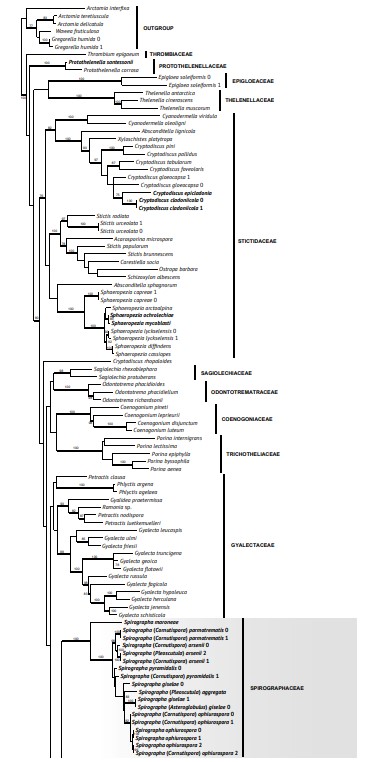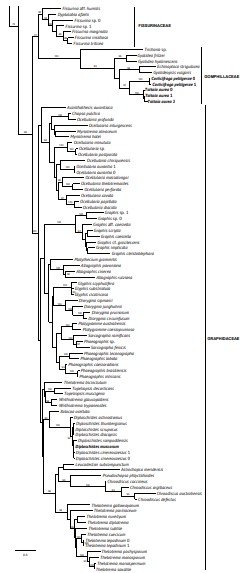Spirographaceae Flakus, Etayo & Miadlikowska, fam. nov.
MycoBank number: MB 833342; Index Fungorum number: IF 833342; Facesoffungi number: FoF 13853;
Diagnosis: A monotypic family of lichenicolous and fungicolous fungi belonging to the Ostropales (Lecanoromycetes). The sexual state characterized by having apothecioid or perithecioid, cleistohymenial ascomata, immersed or sessile on the host thalli or hymenia, single or aggregated on a stroma, with honey-brown, dark-brown or black pigments, a persistent exciple, I– and K/I– hymenium, simple to branched paraphyses, functionally unitunicate asci, ~ 16–32-spored, and 1-septate, hyaline, narrowly ellipsoidal to fusiform, curved or sigmoid ascospores. The asexual state characterized by having immersed, pycnidial conidiomata, hyaline to yellowish brown or dark brown, disintegrating irregularly at the top to release conidia; hyaline, septate, branched conidiophores, holoblastic, synchronous or sympodial conidiogenous cells, and hyaline, Y-shaped, with the main axis and two diverging arms, or triangular, or tetra- to polyhedral conidia.
Type genus: Spirographa Zahlbr.
Description. Ascomata apothecioid or perithecioid, developing in the host thallus or hymenia, cleistohymenial, single or aggregated in stromata, immersed in the host or rarely sessile. Disc hidden (covered by the exciple at maturity) or, if visible, concave, orange-brown, dark- brown or black. Exciple honey-brown, dark-brown or black, K–, N–, prominent, composed of isodiametric to elongate cells, without hairs. Hymenium K/I–, I–, composed of hyaline, simple, slightly branched paraphyses, 1.5–4.0 µm thick, usually apically thickened, covered by gel and granular pigments. Epihymenium with honey-brown, orange-brown or black, pigments granular, K–, N–. Asci clavate to cylindrical, functionally unitunicate, wall apically not thickened, K/I–, I–, ~ 16–32-spored. Ascospores 1-septate, hyaline, narrowly ellipsoidal to fusiform, spirally arranged in asci (except in short-spored species), with rounded or pointed ends, sometimes with large cilia developed on both ends, not constricted at the septa, straight to curved or sigmoid, smooth, without a gelatinous cover. Conidiomata immersed in the host thallus or hymenia, pycnidial, globose to pyriform, hyaline to yellowish brown or dark brown. A pycnidial wall composed of isodiametric to slightly elongated cells, disintegrating irregularly at the top to release a colorless to pale-pink mass of agglutinated conidia. Conidiophores hyaline, septate, thin-walled, arising from the innermost cells of the pycnidial walls, branched. Conidiogenous cells holoblastic, synchronous or sympodial, integrated, terminal to lateral, thin-walled, producing few conidia from minute loci. Conidia hyaline, truncate, aseptate, either Y-shaped, with the main axis and two diverging arms, or triangular, or tetra- to polyhedral.
Notes. The genus Spirographa was introduced by Zahlbruckner (1907) and later classified by Hawksworth and Sherwood (1982) in the family Odontotremataceae in Ostropales. Diederich & Etayo (2000) suggested a placement in Helotiales close to Skyttea. However, Diederich (2004) confirmed that ascomata in the young state are cleistohymenial and maintained the systematic position proposed by Hawksworth and Sherwood (1982). For a long time, the species concept in Spirographa was misunderstood and all known species were incorporated into S. fusisporella s.lat. (Kocourková 2000; Diederich 2004; Santesson et al. 2004; Ihlen & Wedin 2008; Brackel 2014). However, Etayo (2002, 2017) and Diederich (2004) mentioned high morphological variability of S. fusisporella and suggested that further taxonomic studies may split the taxon into several species. An additional two species of Spirographa were described from Usnea (S. usneae) and Sticta (S. longispora) (Flakus & Kukwa 2012b; Etayo 2017) based on morphological characters.
Based on our multilocus phylogenetic analyses (Fig. 23, 24B), we demonstrated that Spirographa forms an independent lineage (recognized as Spirographaceae) within Ostropales, sister to the clade containing Fissurinaceae, Gomphillaceae and Graphidaceae. We also revealed that Cornutispora (Pirozynski 1973), a conidial genus of previously unknown phylogenetic position, represents an asexual state of Spirographa, and that Asteroglobulus (Brackel 2011) together with Pleoscutula (Vouaux 1913; Hafellner 1982) are congeneric with Spirographa (Fig. 24B). Our comprehensive assessment based on molecular, anatomical and ecological data, reveal that species of the re-circumscribed genus Spirographa are strongly host-specific, mainly at the generic level.

Figure 23. Phylogenetic placement of Spirographaceae (highlighted) within Ostropales inferred from ML analyses based on a combined nrLSU, mrSSU, RPB1 and RPB2 dataset for 195 OTUs. Thick branches represent bootstrap values ≥ 70%. The lichenicolous species are bolded. The scale bar represents number of nucleotide substitutions per site.

Figure 23. Continued.

Figure 24. Phylogenetic placement of the Spirographa complex (Spirographaceae) within Graphidaceae s.lat. (A, based on nrLSU, mrSSU and RPB1) and relationships within the Spirographa complex (B, based on nrITS, nrLSU, mrSSU and RPB1), inferred from ML analyses of combined dataset for 144 OTUs and 20 OTUs, respectively. Thick branches represent bootstrap values ≥ 70%. The scale bars represent number of nucleotide substitutions per site.
Genus
